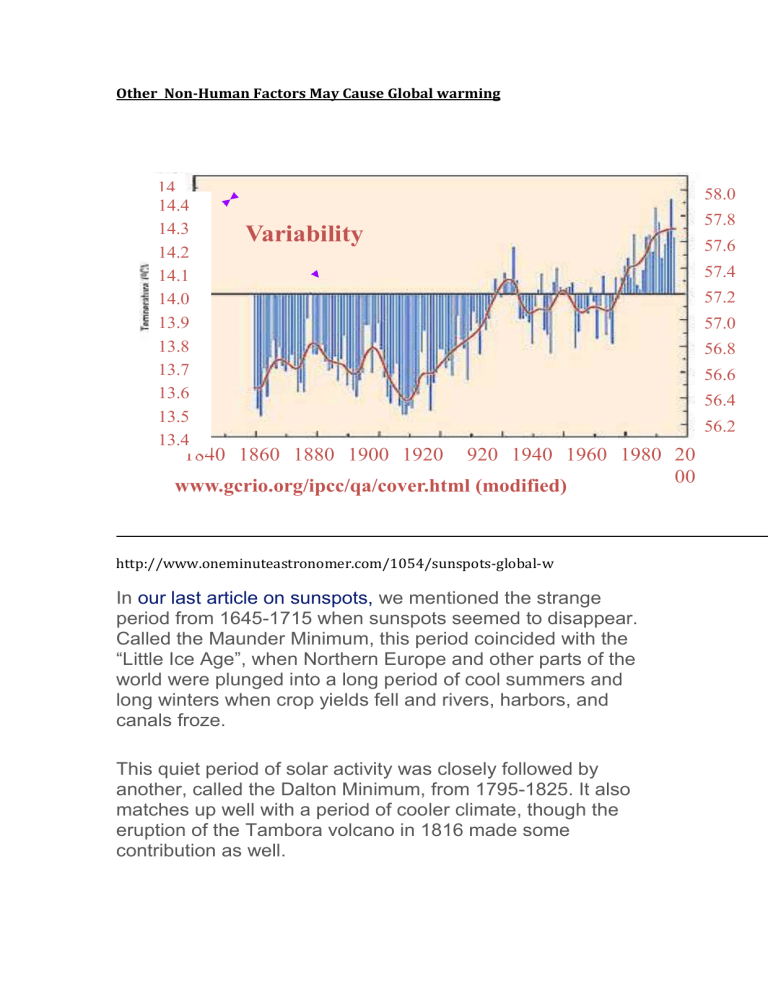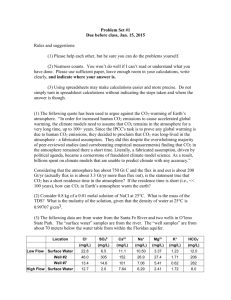File

Other Non-Human Factors May Cause Global warming
14
.5
14.3
14.2
14.1
14.0
Variability
58.0
57.8
57.6
57.4
57.2
13.9
13.8
13.7
13.6
13.5
57.0
56.8
56.6
56.4
13.4
1840 1860 1880 1900 1920 1920 1940 1960 1980 20
www.gcrio.org/ipcc/qa/cover.html (modified)
00
56.2
http://www.oneminuteastronomer.com/1054/sunspots-global-w
In our last article on sunspots, we mentioned the strange period from 1645-1715 when sunspots seemed to disappear.
Called the Maunder Minimum, this period coincided with the
“Little Ice Age”, when Northern Europe and other parts of the world were plunged into a long period of cool summers and long winters when crop yields fell and rivers, harbors, and canals froze.
This quiet period of solar activity was closely followed by another, called the Dalton Minimum, from 1795-1825. It also matches up well with a period of cooler climate, though the eruption of the Tambora volcano in 1816 made some contribution as well.
The sunspot cycles since 1600, showing the Maunder and
Dalton minima
So you may wonder… do periods of little sunspot activity lead to cooler climate on Earth? And do periods of increased sunspot activity, such as occurred from 1900-1950 account for periods of higher temperatures on Earth? Can sunspots explain the rise in temperature during the 20th century, perhaps, rather than greenhouse gases produced by human activity?
In fact, the sun does get hotter when there are more sunspots.
Because alt hough the spots are cooler, they’re accompanied by hotter, brighter patches called faculae that cause the overall brightness of the sun to increase by 0.1% at visible wavelengths, and more at ultraviolet wavelengths.
Such increases in solar brightness are included in climate models. It seems the 11-year sunspot cycle as well as the increase in solar activity earlier in the 20th century lead to an increase in average global temperature of 0.1 to 0.2 Celsius… which is only about 20% of the observed increase of 0.5 to1.0 degree.
So… case closed, right? It is greenhouse gases, and not solar activity, that are the main cause of climate changes this past century?
Well, not so fast. Because when sunspot numbers rise and fall, there’s more going on than simply changes in solar brightness. Periods of reduced sunspot activity correspond to periods of reduced magnetic activity on the sun, and reduced outflows of charges particles from the sun (the so-called solar wind). The solar wind whizzes past the Earth and deflects cosmic rays from deep space from hitting our atmosphere.
A recent proposal from Danish scientists suggest that when cosmic rays strike our atmosphere, they create tiny aerosol particles that lead to increased cloud formation and less sunlight hitting the Earth. So it’s a double whammy… fewer sunspots mean a dimmer sun, which also means more cosmic rays into the atmosphere and more cloud cover which further cools the Earth. And vice-versa when there is more solar activity.
Another recent theory suggests increased UV light from the sun drives energy flow from the upper to lower atmosphere by disrupting a layer of ozone high in the atmosphere. How this affects climate is unclear.
As it turns out (as far as we know), computer models of the climate do not take these indirect effects of solar activity into account when calculating the change in global climate. And while human activity counts for only 5% of carbon dioxide emitted into the atmosphere each year, the sun accounts for
ALL the energy striking the Earth and driving its dynamic and enormously complex ocean currents and atmosphere.
So you see, despite what you hear in the media, there is still much uncertainty about how the Earth’s climate really operates and changes over time, and how changes in solar activity drive climate change. Healthy and open skepticism, as always, is appropriate.
And remember… the Earth is so complex that even the best computer model in the world can’t tell you with any certainty
whatsoever whether you’ll need an umbrella when you head out the door to go the office a week from today.
Volcanoes also warm the climate http://www.wunderground.com/climate/volcanoes.asp
While volcanoes cool the climate on time scales of 1 - 2 years, they act to warm the climate over longer time scales, since they are an important source of natural CO2 to the atmosphere. Reviews of the scientific literature done by
Kerrick (2001) and other authors estimate that volcanoes emit between 0.132 and 0.319 gigatons (Gt) of CO2 to the atmosphere each year, which is about
100 to 300 times less than the 36.3 Gt emitted by humans into the atmosphere in 2008 (Le Quere et al., 2009). According to the USGS , with 50 -
60 volcanoes active on the Earth at any one time, it would take about 11,700 extra volcanoes like Hawaii's Kilauea to scale up volcanic emissions of CO2 to match what humans do. Despite the relatively meager amount of CO2 they put in the air, volcanoes are largely responsible for the natural CO2 in the atmosphere, and helped make life possible on Earth. Why, then, haven't CO2 levels continuously risen over geologic time, turning Earth into a steamy hothouse? In fact, CO2 levels have fallen considerably since the time of the dinosaurs--how can this be? Well, volcano-emitted CO2 is removed from the atmosphere by chemical weathering. This occurs when rain and snow fall on rocks containing silicates. The moisture and silicates react with CO2, pulling it out of the air. The carbon removed from the air is then washed into the sea, where it ends up in ocean sediments that gradually harden into rock. Rates of chemical weathering on Earth have accelerated since the time of the dinosaurs, largely due to the recent uplift of the Himalaya Mountains and
Tibetan Plateau. These highlands undergo a tremendous amount of weathering, thanks to their lofty heights and the rains of the Asian Monsoon that they capture. Unfortunately, chemical weathering cannot help us with our current high levels of greenhouse gases, since chemical weathering takes thousands of years to remove significant amounts of CO2 from the atmosphere. It takes about 100,000 years for silicate weathering to remove
63% of the CO2 in the atmosphere. Thus, climate models predict that chemical weathering will solve our greenhouse gas problem in about 100,000
- 200,000 years.
Experts In
Politics
Don Aitkin
Politics Professor
Disagree
Despite all the hype and the models and the catastrophic predictions, it seems to me that we human beings barely understand
climate. It is too vast a domain. ... we still know little about the oceans, one of the crucial elements in climate processes, not much more about the atmosphere, another such element, a little about solar energy and the effect of the sun's magnetic field on
Earth, and only a little about the land. The
Earth is a big place.
The Common Sense Pitch
Edit Pitches
09 Apr 2008 Source
Sub-Arguments Of This Expert:
Is it possible to accurately predict climate?
Mostly Disagree http://www.takeonit.com/question/263.aspx
S. Fred Singer
Head of NIPCC,
Astrophysics Professor
Mostly Disagree
The gap between the satellite observations and existing theory is large enough to cast serious doubt on all computer-model predictions of future warming. Whatever the cause of the gap, we cannot rely on GCM
(General Circulation Models) forecasts of future warming. (GCMs are not even consistent with each other; their temperature forecasts vary by some 300 percent.) Until
GCMs become validated by actual climate observations, they should not be used as the basis for policy.
The Tenuous Evidence Pitch
Edit Pitches
01 Apr 1999 Source
Sub-Arguments Of This Expert:
Does cosmic radiation significantly affect earth's climate?
Agree
Are the causes of climate change well understood?
Disagree
Jasper Kirkby
Particle Physicist
Mostly Disagree
[Sun and cosmic rays] will probably be able to account for somewhere between a half and the whole of the increase in the Earth's temperature that we have seen in the last century.
Edit Pitches
23 Feb 2007 Source
Sub-Arguments Of This Expert:
Have solar cycles significantly affected earth's recent climate?
Mostly Agree
Does cosmic radiation significantly affect earth's climate?
Mostly Agree
Denis Rancourt
Physics Professor
Disagree
The atmospheric greenhouse effect is a well known natural phenomenon, mostly caused by atmospheric water vapour, that keeps our planet warm and habitable whereas
(anthropogenic = human-made) global warming refers to a small extra greenhouse warming (0.5-1 C/33 C; 1-5 %) allegedly arising from an increase in atmospheric concentration of the minority greenhouse effect gas CO2 (carbon dioxide) – the later increase in turn possibly arising from fossil fuel burning.
Edit Pitches
27 Feb 2007 Source
Michele Bachmann
US Politician, Republican
Disagree
Let’s just go to a fundamental question. Carbon dioxide, Mister
Speaker, is a natural byproduct of nature. ... [Yet] carbon dioxide is portrayed as harmful! ... Human activity contributes perhaps three percent of the three percent. In other words, human activity is maybe 3 percent contributing to the 3 percent of carbon dioxide that’s in Earth’s atmosphere. It’s so negligible — it’s a fraction of a fraction of a fraction of a percent — that it can hardly be — be quantified.









